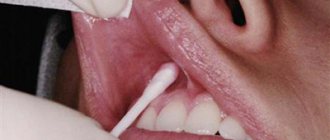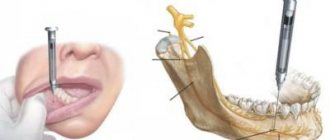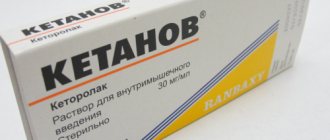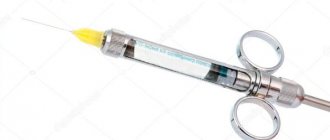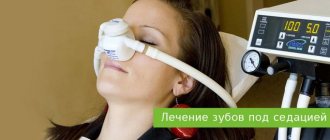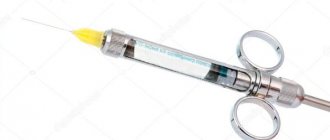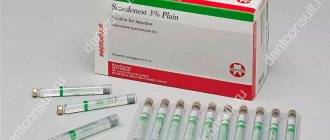Application (terminal, surface) anesthesia is a procedure for non-injection application of surface anesthetics (painkillers) to the oral mucosa. As a result, sensitivity decreases, and the patient does not feel anything within the treated area. Unlike injection techniques, this method is completely painless and is successfully used for anesthesia for shallow and extensive interventions. Can be used alone or in combination with infiltration or conduction anesthesia.
The Mitino Dental Center uses high-quality modern drugs for application (terminal) anesthesia in adults and children. The selection is made taking into account the individual sensitivity of the patient and the type of dental procedure.
What is the procedure
The operating principle of topical anesthesia is to block sensory receptors. When applied to the surface of the mucous layer, the drug quickly penetrates to the nerve endings to a depth of 3-5 mm, blocking the passage of nerve impulses. The analgesic effect begins to appear within a few minutes and lasts up to half an hour, covering adjacent soft and hard tissues.
REFERENCE! The mucous membrane of the oral cavity is densely permeated with blood vessels, so non-injection anesthesia with surface anesthetics takes less time due to faster absorption of the drug.
Application anesthesia has its own list of disadvantages and advantages. Main advantages:
- complete painlessness of the procedure;
- there is no general toxic effect on the body;
- minimal risk of overdose (especially important when working with young children who find it difficult to choose the optimal dose of injectable drugs);
- ease of implementation (the application procedure does not require special skills from the doctor).
The main disadvantages of the method are the short duration of the analgesic effect and the shallow depth of impact. Some drugs can have a vasodilating effect, which increases bleeding during invasive procedures.
How is topical anesthesia performed in dentistry?
The method of implementation does not require special skills from the doctor, however, strict adherence to the instructions allows you to avoid unwanted effects (insufficient pain relief, overdose, tissue damage). Allergy testing is required. This is especially true if the drug contains highly allergenic ingredients, such as propolis.
ATTENTION! For maximum analgesic effect, on the eve of a visit to the dentist, avoid the use of alcohol-containing drugs - ethanol can reduce the effect of anesthetics.
Sequencing:
- The mucous membrane in the intervention area is treated with an antiseptic and dried. The abundance of saliva washes away the drug and interferes with its normal absorption into the gum tissue.
- Following the dosage, an anesthetic is applied (ointment, cream, gel is rubbed into the gum area, a spray or aerosol is sprayed over the surface). Be sure to take into account the location of the tooth, the depth of the intervention and the individual sensitivity of the patient. In particular, different doses of anesthetic will be required to numb incisors and molars.
- After 3-5 minutes (depending on the chosen composition and the individual sensitivity of the patient), the main procedure begins.
The pain relief time depends on the drug and lasts 10-30 minutes. This is taken into account when choosing an anesthetic and, as necessary, it is updated by applying a new batch of the substance.
REFERENCE! The most controversial form of anesthetic is the aerosol. It is quickly absorbed, but pain relief often covers the entire oral cavity. Extensive loss of sensitivity can provoke additional damage (biting the tongue, cheeks, impaired speech function).
Local anesthetics in dentistry
Anesthetics based on Articaine are the most modern in dentistry. Anesthetics of the articaine series are Ultracaine, Ubistezin, Septanest, etc. The effectiveness of these anesthetics is much higher than that of Lidocaine or Novocaine. And Novocain has practically no effect in anesthetizing the area of inflammation.
In addition, most articaine anesthetics contain vasoconstrictors (adrenaline or epinephrine), which reduce the leaching of the anesthetic, which has a positive effect on the duration and active effect of anesthesia.
Ultracaine
– local anesthetic for infiltration and conduction anesthesia in dentistry and during operations on the oral cavity, has a pronounced local anesthetic effect. The active ingredient is articaine hydrochloride + adrenaline hydrotartrate (epinephrine). The onset of action is immediately after administration. Duration of action – from 1 to 3 hours
Advantages:
- Reliable anesthetic effect - 99% of cases of successful anesthesia
- Proven safety - 0.6% adverse events
- Possibility of use in children, pregnant women, elderly patients
Available in three versions, which differ in the content of epinephrine in its composition.
- Ultracaine DS forte (epinephrine content in solution 1:200,000)
- Ultracaine DS (epinephrine content in solution 1:100,000)
- Ultracaine D (without epinephrine and preservatives)
Ubistezin
– local anesthetic for infiltration and conduction anesthesia for wide application in dentistry. Suitable for standard types of surgical interventions during short procedures. The composition of Ubistezin is no different from the same forms of Ultracain.
Advantages:
- Suitable for adults and children over 4 years of age
- Average duration of action: 45 minutes for intrapulpal anesthesia, 120-240 minutes for soft tissue anesthesia
- The onset of the anesthetic effect is 1-3 minutes after administration.
Available in two versions, which differ in the content of epinephrine in its composition.
- Ubistezin (epinephrine content in solution 1:200,000)
- Ubistezin forte (epinephrine content in solution 1:100,000)
Septanest
– a preparation for local anesthesia based on articaine for use in dentistry. Unlike the first two anesthetics, it contains preservatives such as sodium metabisulfite and ethylenediaminetetraacetate, which have a powerful allergenic effect.
Available in two versions, which differ in the content of epinephrine in its composition.
- Septanest (epinephrine content in solution 1:200,000)
- Septanest (epinephrine content in solution 1:100,000)
Scandonest
– an anesthetic without a vasoconstrictor component. Suitable for adults and children. The onset of the anesthetic effect is 1 to 3 minutes after administration.
Indications for use:
- Anesthesia for simple tooth extraction, tooth preparation
- Ideal for treating patients with contraindications to vasoconstrictor supplements, especially for patients with cardiovascular disease
Advantages of the drug Skandonest:
- Contains 3% mepivacaine
Does not contain other additives and epiniphrine, therefore, it is suitable specifically for patients suffering from cardiovascular pathology and who have contraindications to vasoconstrictor supplements
Read on topic: Removal and treatment of teeth during sleep (sedation)
Indications for use in dentistry
Application anesthesia is indicated for all patients with increased anxiety to create a favorable mood at the dentist’s appointment. However, the direct purpose of this method is to relieve pain from superficial procedures, such as:
- removal and application of sutures;
- injections (intermediate pain relief reduces any discomfort to zero);
- prosthetics (fitting of crowns and bridges);
- taking impressions (if the gag reflex is pronounced, the anesthetic is applied to the basal area of the tongue);
- procedure for cleaning teeth and removing tartar;
- treatment of periodontal pockets, treatment of periodontitis and gingivitis;
- treatment of uncomplicated caries of superficial and moderate severity;
- any manipulations with increased sensitivity of tooth enamel (preparations are rubbed directly into the tooth enamel and adjacent tissues);
- treatment of pulpitis (for local anesthesia of the inflammatory process, the drug is placed at the bottom of the carious cavity);
- removal of baby teeth or teeth with pathological mobility (for example, with periodontal disease);
- opening of gingival abscesses.
The main contraindication to topical anesthesia is an allergic reaction and hypersensitivity to the drug.
In rare cases, when infiltration anesthesia is strictly contraindicated for a patient, application anesthesia is the only way to somehow reduce pain.
About carpuled anesthetics, syringes and needles for local anesthesia
Dental centers, including ours, use not ampoule, but carpule anesthetics of the latest generations. The drugs are in special containers - cartridges, which are inserted into a carpule syringe. The thinnest disposable needles are used for syringes. Carpuled anesthetics are used by doctors taking into account pharmacological characteristics, including additives.
The carpule syringe is easy to use, allows you to take an aspiration sample, insert a needle and inject with one another. It can be easily sterilized in an autoclave, which is used by most dentists. Ease of use reduces the risk of intravascular injection and needle deviation in tissue from the chosen trajectory.
The needle is fixed using a thread of European or American standard. Naturally, all consumables are absolutely sterile, their tips are in excellent condition - sharpened and specially coated, making the injection less traumatic.
Advantages of anesthesia using carpuled anesthetics:
- Absolute sterility. The ampoule does not open, and therefore there is no contact of the solution with the air.
- Exact dosage. All drugs, including those that protect the anesthetic from decay, are in the required dosages.
- No pain. The needle of the syringes is thinner than regular ones and has a special angle and sharpening pattern, which reduces the pain sensation to almost zero.
Application in pediatric dentistry
The technique is popular in pediatric dentistry, as it allows you to completely anesthetize any dental procedure, creating a trusting attitude towards doctors in young patients.
The porous structure of children's primary teeth is especially susceptible to topical anesthesia. The drug easily penetrates tissue, turning off sensitive receptors even in the deep layers of the gums. This allows the method to be used as the main method of pain relief - not only for superficial procedures, but also for the treatment of deep caries of primary teeth.
ATTENTION! In pediatric dentistry, drugs with a low level of toxicity are used. Drugs such as Dicaine are contraindicated for use in patients under 10 years of age.
Preparations used for topical anesthesia
Local topical anesthesia often contains the same types of active ingredients as injection anesthesia (lidocaine, dicaine, bumecaine, etc.), but in higher concentrations. The composition is often supplemented with antiseptics, inflammatory process blockers, and flavorings. The main forms of release are cream, gel, ointment, spray, aerosol.
The entire list of available tools can be divided according to the principle of action:
- cauterizing agents - acid-containing preparations that can seal dentinal tubules and close nerve endings from external influences;
- dehydration compounds - preparations based on carbonic acid salts dehydrate tissue, constricting blood vessels and depriving the tissue of sensitivity (more suitable for superficial manipulations such as brushing teeth and removing tartar);
- analgesic liquids with a high concentration of anesthetic compounds block the conduction of peripheral nerve fibers (the most common group of anesthetics);
- preparations of physiological effects based on strontium, fluorine, sulfides - block the transmission of impulses to nerve endings (such drugs often have an additional therapeutic effect and can be used to treat and strengthen enamel, protect against caries);
ATTENTION! Despite the safety and simplicity of the method, using topical anesthetics yourself at home is undesirable. In each individual case, the dentist selects and prescribes the drug individually, taking into account the source of pain and the personal characteristics of the patient.
